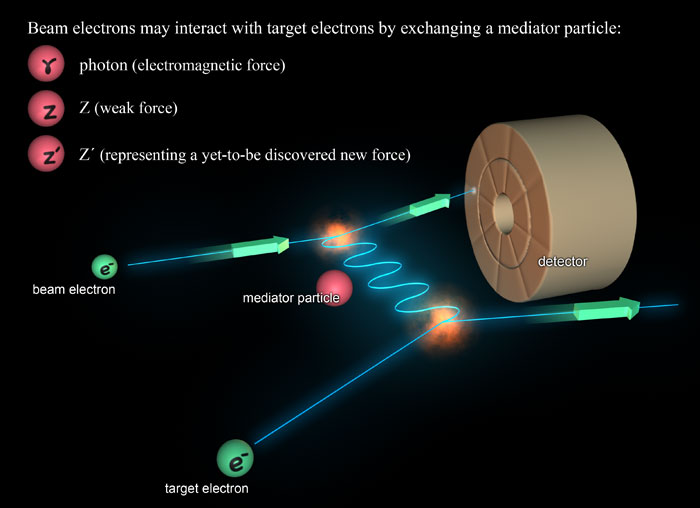SLAC E158: Measuring the
Electron's WEAK Charge
Studying electron-electron Scattering in
MIRROR WORLDS
to search for New Phenomena at the
Energy Frontier
Experiment Description
The electron beam for E158 is produced at the Polarized Electron Source by photoemission, using a circularly polarized laser beam and a strained GaAs photocathode. The electron polarization is ~90%. The beam is accelerated to high energy in the two-mile SLAC Linac (Linear Accelerator) and then transported through a 24.5-degree bend angle in the A-line to a liquid hydrogen (LH2) target in End Station A (ESA). Pulsed magnets were installed in the DRIP (Damping Ring Intersection Point) region of the Linac to allow interleaved operation of the E158 experiment with the BaBar Experiment at the PEP-II storage ring.
E-158 measures the left-right parity violating asymmetry in Møller (electron-electron) scattering of 48.3 GeV longitudinally-polarized electrons from atomic electrons in a liquid hydrogen target. Target electrons, in a 1.5-meter long cell of liquid hydrogen, are bombarded by a 48 GeV electron beam. Møller electrons (beam electrons scattering from target electrons) are isolated from "ep" electrons (electrons scattered by protons in the LH2 target) by a forward magnetic spectrometer consisting of a 3-dipole “chicane” and four quadrupole magnets. Møller electrons of interest traverse through the bores of the quadrupoles and are brought to focus in a ring on a calorimeter located 60 meters downstream of the target.

Target, Spectrometer and Detector
configuration in End Station A
E158 measures the parity-violating asymmetry
in Møller (electron-electron) scattering,

where SR and SL are the scattering rates for incident right- and left-polarized electron beams. This parity violation (PV) arises from interference between the weak (Z - exchange) and electromagnetic (photon - exchange) scattering amplitudes depicted in the figure below.
The PV asymmetry, APV, measured by E158 is tiny: approximately 130 parts per billion (ppb)! That this asymmetry is so small comes not from the electron's Weak Charge, QW(e), being this tiny; but instead it comes from the kinematics of the momentum transfer and the large mass of the Z particle that mediates the weak interaction. The dependence of the Møller-scattering asymmetry on this kinematics and QW(e) is given by

The electron's weak charge*, QW(e), is approximately -0.04 and has a magnitude comparable to its electromagnetic charge, a manifestation of how electromagnetism and the weak force are components of a unified electroweak force. The scattering amplitude for (massless) photon exchange is proportional to the photon propagator, Mg ~ 1/Q2, where Q is the momentum transfer in the scattering. For E158, Q is approximately 0.17 billion electron-Volts (0.17 GeV) independent of whether the electron scattering takes place by photon or Z exchange. This momentum transfer, Q, is much smaller than the mass of the Z particle, which is 91 billion electron-Volts (91 GeV). At this low momentum transfer, the scattering amplitude for a Z exchange is inversely proportional to the square of its mass, MZ ~ [1/M(Z)]2. The E158 detector sees about 3 electron-electron scattering events with a Z particle participating in the scatter for every million scatters involving only photon exchange, a ratio of 3 parts per million. And the asymmetry in the scattering rate, APV, is another factor 20 times smaller than this.
E158 continues a successful program at SLAC studying parity violation in the weak neutral force (Z0 interactions) that began with Charles Prescott's historic experiment SLAC E122 in 1978. E122 made the first observation of PV in a weak neutral scattering interaction, by observing PV in deep inelastic scattering of polarized 19.4 GeV electrons from an unpolarized liquid deuterium target. It was one of the cornerstone experiments that solidified the Standard Model (SM) developed by Glashow, Weinberg and Salam to describe electroweak interactions.
At SLAC and elsewhere in the 1990s, precision measurements probing quantum effects from physics at higher energy scales were very successful. Precision electroweak measurements accurately predicted the mass of the top quark before it was discovered at the Tevatron at Fermilab, and they were cited in the awarding of the 1999 Nobel Prize to Veltmann and t'Hooft, which recognized their work in developing powerful mathematical tools for calculating quantum corrections and demonstrating that the Standard Model was a renormalizable theory. The discovery and mass measurement of the top quark at Fermilab's Tevatron and the precise Z0 boson mass measurement from CERN experiments added to well established values for other Standard Model parameters, to allow predictions for the only Standard Model parameter not yet measured, the Higgs mass.
E158 performed 3 physics runs in 2002 and 2003. Details on the experiment, apparatus and analysis can be found in the E158 Ph.D. theses.
*The electron's weak charge, QW(e), is related to the weak mixing angle by the equation, QW(e) = -(1-4sin2qW).

Content Woods
